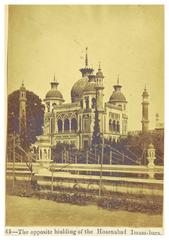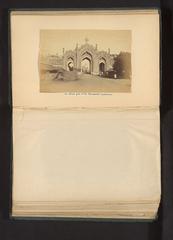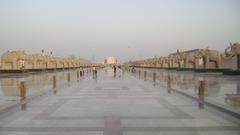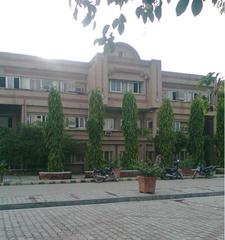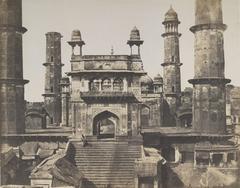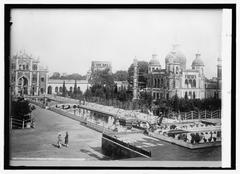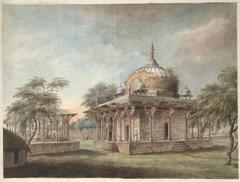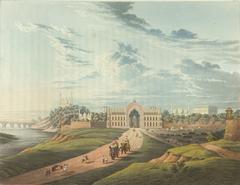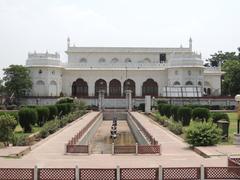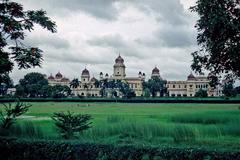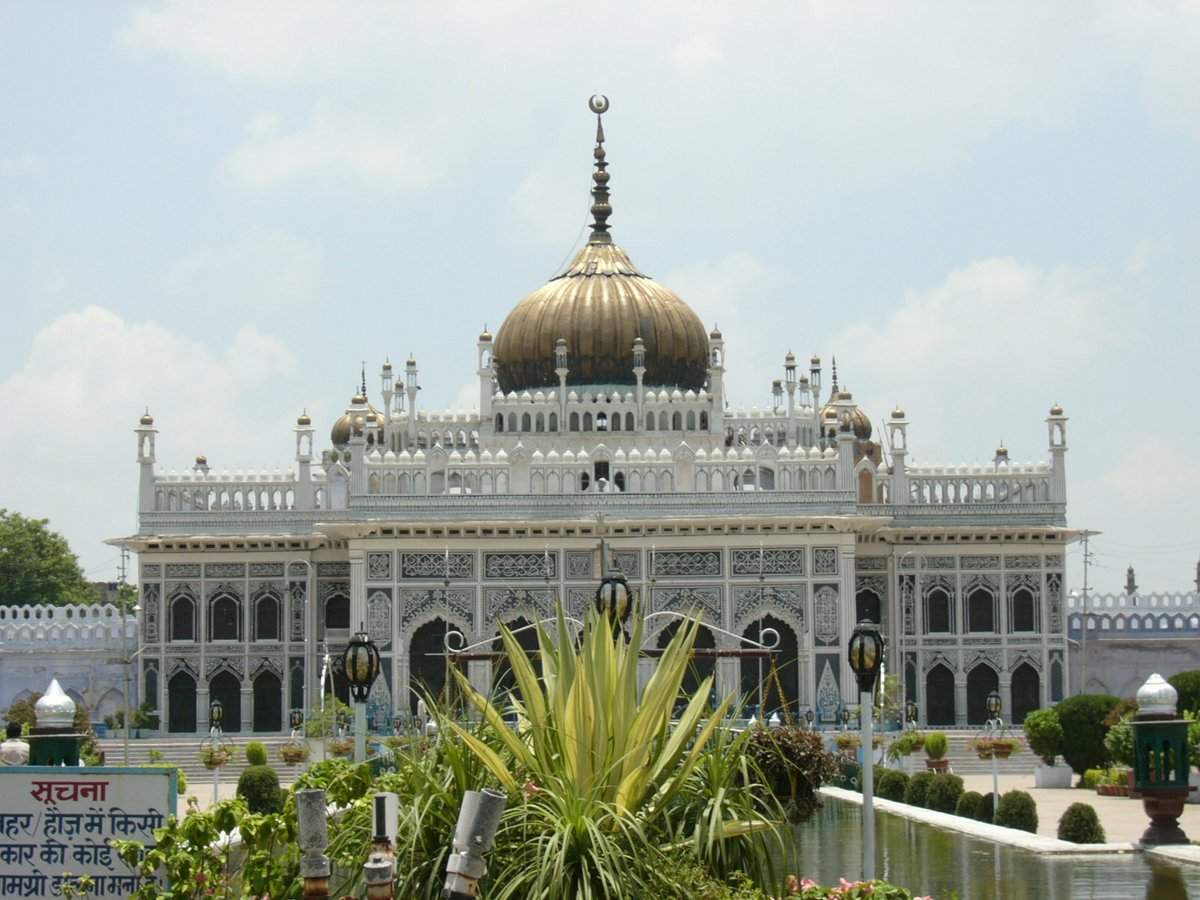
Chhota Imambara Visiting Hours, Tickets, and Historical Sites in Lucknow
Date: 17/07/2024
Introduction
Nestled in the heart of Lucknow, India, Chhota Imambara, also known as Imambara Hussainabad Mubarak, stands as an emblem of the city’s rich historical tapestry and architectural grandeur. Erected in 1837 by Nawab Muhammad Ali Shah, the then ruler of Awadh, this monument is not just a mere structure but a living testament to the cultural and religious ethos of the Nawabs’ era. The origins of Chhota Imambara are steeped in compassion, as its construction was initiated to provide employment during a severe famine, showcasing the Nawab’s benevolence (source). Today, it remains a symbol of Shia Muslim identity, especially vibrant during the mourning period of Muharram, and is an architectural marvel blending Mughal and Indo-Islamic styles. From its grand gateway to the serene courtyard, every aspect of Chhota Imambara reflects a harmonious fusion of aesthetics and functionality, making it a must-visit destination for history buffs, architecture enthusiasts, and curious travelers alike.
Table of Contents
- Introduction
- A Glimpse into the Past - History and Cultural Significance
- Architectural Heritage - A Blend of Mughal and Indo-Islamic Styles
- A Symbol of Shia Identity and Muharram Commemorations
- Beyond Architecture - Treasures Within and Cultural Significance
- Visitor Information - Tickets, Visiting Hours, and Travel Tips
- Nearby Attractions and Accessibility
- Special Events and Guided Tours
- Photographic Spots
- Preservation and Legacy - A Shared Responsibility
- FAQ Section
- Conclusion
A Glimpse into the Past - History and Cultural Significance
Chhota Imambara was built in 1837 by Nawab Muhammad Ali Shah, the then ruler of Awadh, as a means of providing employment and sustenance to his people during a devastating famine. This act of compassion not only alleviated the suffering of the masses but also resulted in the creation of an architectural wonder.
The Story Behind the Structure - Famine Relief and Royal Patronage
The year was 1837. A devastating famine gripped the region of Awadh, leaving its people struggling for survival. Nawab Muhammad Ali Shah, the then ruler, conceived the construction of Chhota Imambara as a means of providing employment and sustenance to his people. This act of compassion not only alleviated the suffering of the masses but also resulted in the creation of an architectural marvel.
Architectural Heritage - A Blend of Mughal and Indo-Islamic Styles
Chhota Imambara is a stunning example of the syncretic architectural style prevalent during the late Mughal era. The structure beautifully blends elements of Mughal architecture, known for its grandeur and symmetry, with regional Indo-Islamic influences.
- The Grand Gateway - The gateway, or the Rumi Darwaza, is not just an entrance but a spectacle in itself. Towering over the complex, it is adorned with intricate calligraphy and geometric patterns, reflecting a strong Mughal influence.
- The Central Hall - The main hall of the Imambara is an expansive space, designed to accommodate large gatherings during Muharram. Its high ceilings, arched doorways, and delicate stucco work create an aura of spaciousness and grandeur.
- The Twin Minarets - Flanking the central hall are two elegant minarets, adding a vertical dimension to the structure. These minarets, accessible by spiral staircases, offer panoramic views of the city.
- The Serene Courtyard - The Imambara is set amidst a sprawling courtyard, enclosed by high walls. This courtyard, with its lush greenery and fountains, provides a tranquil escape from the bustling city outside.
A Symbol of Shia Identity and Muharram Commemorations
Chhota Imambara holds immense religious significance for the Shia Muslim community. It serves as an Imambara, a congregation hall for Shia Muslims, particularly during the mourning period of Muharram.
- Muharram at Chhota Imambara - During Muharram, the Imambara transforms into a hub of religious activity. Elaborate processions, known as Taziya, are taken out, commemorating the martyrdom of Imam Hussain, the grandson of Prophet Muhammad.
- The Significance of Taziyas - Taziyas are miniature replicas of the Imam’s tomb, often crafted with exquisite detail and artistry. They are carried in processions and eventually buried, symbolizing the mourning and sacrifice associated with Muharram.
Beyond Architecture - Treasures Within and Cultural Significance
Chhota Imambara is not just about its impressive architecture; it also houses a treasure trove of artifacts and decorative elements that offer a glimpse into the opulent lifestyle of the Awadh court.
- Intricate Chandeliers - The Imambara is renowned for its exquisite collection of chandeliers, many of which were imported from Europe. These glittering chandeliers, along with numerous lamps, illuminate the space, creating a mesmerizing spectacle.
- The Crown of Awadh - One of the most prized possessions housed within the Imambara is the crown of the Awadh dynasty. This crown, adorned with precious jewels, is a testament to the wealth and grandeur of the Nawabs.
- A Cultural Hub - Beyond its religious significance, Chhota Imambara has become a cultural landmark of Lucknow. It attracts visitors from all walks of life, who come to admire its architectural splendor and immerse themselves in the city’s rich history.
Visitor Information - Tickets, Visiting Hours, and Travel Tips
To make the most of your visit to Chhota Imambara, here are some essential details:
- Visiting Hours - Chhota Imambara is open daily from 6:00 AM to 5:00 PM.
- Ticket Prices - The entry fee is INR 25 for Indian citizens and INR 300 for foreign tourists.
- Travel Tips - It is advisable to visit early in the morning or late in the afternoon to avoid the crowds and enjoy the tranquil ambiance. Comfortable footwear is recommended as the complex involves a fair amount of walking.
Nearby Attractions and Accessibility
While you’re in the area, consider exploring other historical sites nearby:
- Bara Imambara - Another magnificent Imambara built by Asaf-ud-Daula, known for its central hall without any supporting beams.
- Rumi Darwaza - This iconic gateway, often compared to the Arc de Triomphe, is a short walk from Chhota Imambara.
- Hussainabad Clock Tower - Located close to Chhota Imambara, this towering clock tower is a striking landmark.
Accessibility - Chhota Imambara is accessible by road, and local transport options like auto-rickshaws and taxis are readily available. The nearest railway station is Lucknow Charbagh, approximately 5 km away.
Special Events and Guided Tours
- Special Events - The Imambara hosts various cultural and religious events throughout the year, with Muharram being the most significant.
- Guided Tours - For a deeper insight into the history and architecture, consider hiring a local guide or joining a guided tour. These tours often provide fascinating anecdotes and historical context that enrich the experience.
Photographic Spots
Chhota Imambara offers numerous picturesque spots for photography enthusiasts:
- The Grand Gateway - Capture the stunning Rumi Darwaza in all its glory.
- The Central Hall - The intricate interiors and chandeliers make for beautiful photographs.
- The Serene Courtyard - The lush greenery and fountains provide a perfect backdrop for memorable shots.
Preservation and Legacy - A Shared Responsibility
Today, Chhota Imambara stands as a protected monument under the Archaeological Survey of India. Efforts are underway to preserve its architectural integrity and cultural significance for generations to come. As visitors, it is our responsibility to appreciate and respect this historical gem, ensuring that its legacy continues to inspire awe and wonder.
FAQ Section
Q: What are the visiting hours for Chhota Imambara? A: Chhota Imambara is open daily from 6:00 AM to 5:00 PM.
Q: How much do tickets cost for Chhota Imambara? A: The entry fee is INR 25 for Indian citizens and INR 300 for foreign tourists.
Q: Are there guided tours available at Chhota Imambara? A: Yes, guided tours are available and provide a deeper insight into the history and architecture of Chhota Imambara.
Conclusion
Chhota Imambara is more than just a historical monument; it is a journey through the annals of Lucknow’s rich cultural heritage and architectural brilliance. From its compassionate beginnings during a devastating famine to its current status as a symbol of Shia identity and a hub of cultural activities, Chhota Imambara encapsulates the essence of the Nawabs of Awadh’s legacy. The intricate chandeliers, the grand gateway, and the serene courtyard all contribute to its timeless allure. As visitors, it is our responsibility to appreciate and preserve this gem, ensuring that its legacy continues to inspire awe and wonder for generations to come. For those planning a visit, Chhota Imambara promises a memorable experience that blends history, architecture, and cultural significance (source). Don’t miss the opportunity to explore this iconic landmark and immerse yourself in the rich tapestry of Lucknow’s heritage. For more updates and information, follow us on our social media channels and download our mobile app Audiala.
References
- Cultural India. (n.d.). Chhota Imambara. Retrieved from Cultural India



